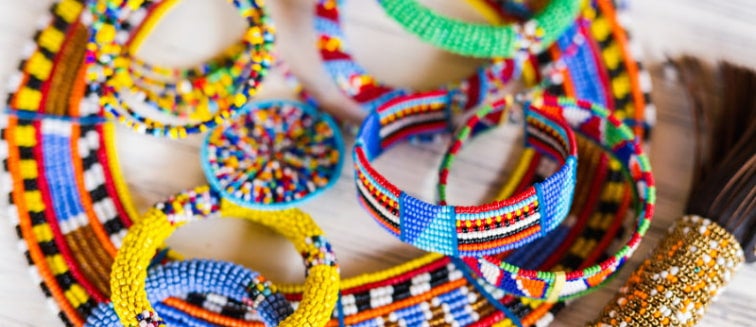Finding the perfect souvenir in Tanzania can be more than just buying a gift; it’s an opportunity to carry home a piece of its rich culture and history. Imagine strolling through vibrant local markets where the aroma of exotic spices mingles with the rhythmic beats of traditional Tanzanian drums. This isn’t just shopping, it’s a sensory journey into a land brimming with diversity and tradition.
Tanzania offers a myriad of choices for the discerning shopper, from intricate Maasai beadwork to beautiful Tinga Tinga paintings. The Maasai love beads have been an integral part of their culture for centuries, representing everything from beauty to social status. In fact, these vividly colored pieces are not only souvenirs but also a vibrant portrayal of Tanzanian heritage and craftsmanship.

Exploring Tanzanian Souvenirs: A Reflection of Culture and Tradition
The souvenirs from Tanzania are more than just keepsakes; they are a bridge to its rich cultural heritage. When you buy a piece of Maasai beadwork, you’re purchasing a symbol deeply rooted in Maasai identity and storytelling. Each color and pattern signifies different aspects of their life. According to the here is the article, these beads are not only beautiful but culturally profound. This adds layers of meaning to every piece you take home.
Wood carvings, especially those made from Mpingo trees, are another notable souvenir. These intricate sculptures often depict wildlife and daily life scenes, showcasing the talent of Tanzanian artisans. They are not just decorations; they serve as a testament to the dedication and skill of the woodworkers. Having one of these pieces in your home can be a constant reminder of your journey. The deep black hue of the Mpingo makes each carving uniquely striking.
Tingatinga paintings are hard to miss in Tanzanian markets, with their bright colors and distinctive style. Originating in the 1960s, this art form reflects both everyday life and imaginative scenes through vibrant hues and bold brushstrokes. These paintings offer a slice of Tanzanian creativity that you can easily take with you. For many tourists, picking up a Tingatinga painting means they’re bringing back a piece of Tanzanian history and culture. They make for excellent conversation starters.
Textiles and fabrics are also popular among visitors. Beautifully adorned kangas and kitenges are used for clothing, decorations, and more. They come in an array of patterns and colors, each with its own story. Shopping for these fabrics can give you a deeper appreciation for Tanzanian craftsmanship. Plus, they’re practical souvenirs that can be used daily or kept as a piece of the country’s vibrant culture.
Traditional Tanzanian Crafts
Tanzania boasts a rich tradition of crafts that tell the story of its diverse cultures. Maasai beadwork is one such treasure, where each bead color has a particular significance, representing unity, strength, and beauty. These intricate designs not only enhance clothing and jewelry but also carry deep cultural meanings. Such beadwork isn’t just for show; it’s an integral part of Maasai identity. Owning a piece lets you connect with their vibrant heritage.
Wood carving in Tanzania is another form of art deeply rooted in tradition. Skilled artisans carve everything from masks to animal figurines, often from the Mpingo tree, also called the African Blackwood. The carvings are highly detailed and can represent daily life, spiritual beliefs, or famous Tanzanian wildlife. Bringing home a carved piece allows you to share a story of Tanzania’s rich artistry. It’s like having a piece of the country’s soul in your space.
Basket weaving is widespread among many Tanzanian communities. Crafted from locally sourced materials, these baskets vary in design and function. They can be used for anything from carrying goods to serving as decorative pieces. The intricate patterns and sturdy designs are a testament to the weavers’ skill and creativity. These baskets also make practical and stylish souvenirs.
Traditional pottery is another craft to explore. Pottery making involves shaping and firing clay into vessels that serve both functional and decorative purposes. The designs often reflect the potter’s community and heritage. Each piece is unique, with variations in texture and glaze. Owning Tanzanian pottery connects you to the hands that molded it and the rich traditions behind this timeless craft.
Textiles and Fabrics Unique to Tanzania
Tanzanian textiles are renowned for their vibrant colors and intricate designs. One popular fabric is the kanga, which often features bold patterns and Swahili proverbs. These proverbs reflect local wisdom and cultural identity. Wearing or gifting a kanga means you’re sharing these stories with others. It’s more than just a fabric; it’s a piece of Tanzanian heritage.
Another fabric, known as kitenge, is widely used for clothing and decorative purposes. Kitenges are dyed using vibrant, long-lasting colors and showcase diverse patterns. Each piece is a work of art. Many choose kitenges for their versatility. They can be worn as skirts, dresses, and even headwraps, adding a fashionable touch to any outfit.
Handwoven textiles are another category to explore. Crafted by local artisans, these textiles employ traditional weaving techniques passed down through generations. They often feature natural dyes and intricate designs. These fabrics can be used as blankets, tablecloths, or home décor. Purchasing handwoven textiles supports local communities and preserves their weaving traditions.
Batik fabric is also a significant part of Tanzanian culture. The batik-making process involves using wax to create patterns on fabric before dyeing it. This technique results in unique, often stunning designs. No two batik fabrics are exactly alike. They are used for everything from clothing to wall hangings, making them versatile and beautiful keepsakes.
The Art of Choosing the Right Souvenirs
When looking for the perfect souvenir, it’s important to consider the cultural significance of the item. A Maasai beadwork bracelet, for example, isn’t just a piece of jewelry; it’s a cultural symbol. These pieces often carry stories and meanings unique to the Maasai people. Opt for items that tell a story. This way, you take home more than a physical object.
Another key factor is the craftsmanship involved. Handcrafted items, like wood carvings or batik fabrics, showcase the skill and creativity of Tanzanian artisans. Quality craftsmanship ensures that your souvenir isn’t just a keepsake, but a piece of art. These items often last longer and look better. Taking time to choose high-quality items pays off in the long run.
It’s also wise to think about the practicality of your souvenir. Items such as textiles and fabrics can be used daily, adding a touch of Tanzania to your life. Kangas and kitenges, for example, can be worn or used as home décor. Practical souvenirs offer both functionality and fond memories. They keep your experience fresh in your mind.
Budget is another consideration when selecting souvenirs. While it may be tempting to buy the first item you see, it’s better to shop around. Compare prices and quality across different vendors. This ensures you get the best value for your money. Moreover, haggling is a common practice in local markets, so don’t hesitate to negotiate.
Lastly, consider supporting local communities through your purchases. Buying directly from local artisans ensures that they receive fair compensation for their work. Ethical shopping helps sustain traditional crafts and local economies. It’s a win-win situation: you get a unique souvenir and help the community. This makes your purchase more meaningful and impactful.
Key Takeaways
- Maasai beadwork is a colorful, culturally meaningful craft.
- Kanga and kitenge fabrics are vibrant and multi-functional.
- Wood carvings from Mpingo trees showcase artisans’ skills.
- Tingatinga paintings offer unique, vivid art.
- Supporting local artisans helps sustain traditional crafts.

